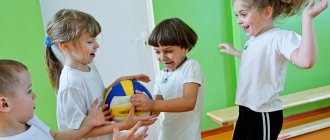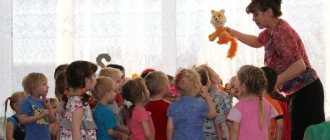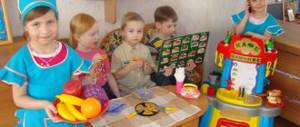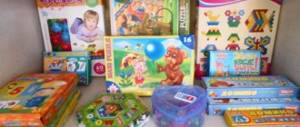Games to develop communication skills of primary schoolchildren
Role-playing game "Little Helpers"
Target. Encourage children to help with housework, teach joint activities and communication.
Progress of the game: The teacher reads a poem. At the right time, at his signal, each of the children shows how he knows how to do his job.
I offer some techniques for working on developing communication skills.
1. Constructing reasoning according to the scheme.
2. Compilation of texts including evaluative statements.
What a beauty!
How handsome he is! What happiness! What a joy! 3. Continue the series:
Water (in the river): clean, transparent, cloudy, ..., ...;
makes noise, seethes, splashes, ..., .... Rain: heavy, torrential, heavy, ...., ...; Sky: blue, blue, transparent, gloomy, ..., ...; turns pink, frowns, covered with clouds, …, …. 4. Language games.
"Who is bigger?" The players are divided into two teams.
The presenter offers the floor. For example, soft. Participants in the game must verbally compose as many short sentences and statements with this word as possible. A variant of this game is to compose sentences on a specific topic, for example, “Summer”. Corrective speech exercises were also used when working with children. Exercise No. 1. “Role communication.”
The participants are divided into two groups, the first group is journalists who take interviews, in the second group everyone chooses who he will be (athlete, businessman, president, etc.) and, based on his role, must answer questions from journalists during 3-5 minutes.
Finally, they discuss: Was it easy to communicate based on a certain role? What experiences and thoughts arose during the exercise? What did it help you understand? Exercise No. 2. “Transfer of feelings.”
Everyone stands in a line, at the back of each other’s head, the first person turns to the second and conveys to him with facial expressions some feeling (joy, anger, sadness, surprise), the second person must convey the same feeling to the next, etc.
the latter is asked what feeling he received and compares it with what feeling was sent at the beginning, and how each participant understood the feeling he received. Exercise No. 3. “Strengths.”
Purpose of the exercise: to help group members understand that any situation can be analyzed without judgment, finding strengths in it.
Instructions: participants are divided into pairs: the first member of the pair tells his partner about his difficulty or problem for a minute. The second, after listening, must analyze the situation in such a way as to find strengths in the partner’s behavior and talk about it in detail. Then the roles change. After completing the exercise, the group discusses: was everyone able to find strengths in their partner’s behavior? Who found it difficult to do this, and why? Exercise No. 4. “Empathy.”
Instructions: all members in the circle listen to one of the participants who says an emotionally charged phrase.
Everyone, in turn, names the feeling that, in his opinion, the speaker is experiencing. Exercise No. 5.
"Through the glass." Purpose of the exercise: developing mutual understanding between communication partners at the non-verbal level.
One of the participants transmits the text as if through glass, i.e. facial expressions and gestures: others call it understood. The degree of agreement between the transmitted and understood text indicates the ability to establish non-verbal contacts. Role-playing game "Difficult decision".
Children are offered this or that situation for discussion.
For example: “You have a very close friend. You met another boy (girl) who your friend didn’t like, but you really liked. What to do in such a situation. How can you explain to your friend that your new comrade is not a bad person at all? Role-playing game "Carousel".
Purpose: - developing quick response skills when making contacts; — development of empathy and reflection in the learning process. The game involves a series of meetings, each time with a new person. Task: it’s easy to get in touch, keep up the conversation and say goodbye. Group members stand according to the “carousel” principle, i.e., facing each other and form two circles: an internal stationary one and an external mobile one. Examples of situations: - In front of you is a person whom you know well, but have not seen for quite a long time. Are you happy about this meeting... - There is a stranger in front of you. Meet him... - There is a small child in front of you, he was scared of something. Approach him and calm him down. — After a long separation, you meet a friend (girlfriend), you are very happy to meet... The time to establish contact and conduct a conversation is 3-4 minutes. Then the presenter gives a signal, and the training participants move to the next participant. Using these exercises, you can develop communication skills. Game "What's in what?" To play you need a set of object pictures or the objects themselves. Children are shown objects (pictures) one at a time and asked what each object has (that is, what it consists of). for example, what a chair has (legs, seat, back), a TV (screen, buttons, body), a dog (paws, tail, head). Subsequently, the rules of the game become more complicated, and it gradually begins to be used only in the verbal version. To organize the answers of the players, you can use a ball: they throw the ball to the child and say a word, for example: “house”, and he must name any part of this object, for example “roof”, “pipe”, “window” or “door”. Game “Circle of Friends” Standing or sitting in a circle, everyone should hold hands, shake them, look at everyone in turn. Game "Friendship Relay". Hold hands and pass a handshake like a baton. The teacher begins: “I convey my friendship to you, and it goes from me to Masha, from Masha to Sasha, etc. And finally it comes back to me. I feel like there is more friendship as each of you added a piece of your friendship. Let it not leave you and warm you. Goodbye!" Game "Sun Rays". Stretch your hands forward and join them in the center of the circle. Stand quietly, trying to feel like a warm ray of sunshine. Exercise “What is my name” Children say their name: short, full, affectionate, most beloved. Game “Touch the...”. Today we got to know each other better, learned everyone’s favorite names, warmed each other with the warmth of the sun, and now take a good look at each other, who is wearing what and what color of clothes. The teacher suggests: “Touch the blue!” Everyone must orient themselves as quickly as possible, find something blue in the participants’ clothes and touch this object. The colors change periodically; those who didn’t have time are the presenter. The teacher makes sure that each participant is touched. Game "Ball in Hand". The teacher takes turns throwing the ball to each child in the circle, and the one who catches it must answer the question: “What do you love most?” or “What do you dislike most?” or “What do you like to do?” or “What are you most afraid of?” Game “The wind blows on...”. With the words “the wind blows on...” the teacher begins the game. In order for all participants in the game to learn more about each other, the questions could be as follows: “The wind blows on the one with blond hair” - all the blond ones gather in one pile. “The wind blows on the one who has a brother, sister... who loves sweets the most, etc.” Game "Dragon". The players stand in a line, holding their shoulders. The first participant is the “head”, the last one is the “tail” of the dragon. The "head" must touch the "tail" and touch it. The dragon's "body" is inseparable. Once the "head" grabs the "tail", it becomes the "tail". It would be desirable for more participants to play both roles. Exercise “Grow into the ground.” Try to press your heels very, very hard onto the floor, fold your hands into fists, clasp your teeth tightly. You are a mighty, strong tree with strong roots, and no winds are afraid of you. This is the pose of a confident person. Exercise “Relieve fatigue.” Stand up, spread your legs wide, bend them slightly at the knees, bend your body and lower your arms freely, straighten your fingers, bow your head to your chest and open your mouth, sway slightly to the sides, forward, backward. Now shake your head, arms, legs, and body sharply. You shake off the fatigue, a little is left, repeat again. Game "Missing Words". The teacher says a sentence and the children fill in the missing words. for example: “She sat on the threshold and meowed pitifully...” “The cat caught it in the garden...” “The cat’s fur... claws...” “The rain passed because of the cloud, it seemed...” “The janitor took a broom, he will...” “The postman came, he brought..." In the future, the child and the teacher can change roles; the child comes up with a sentence and the teacher finishes it. Guess game. Matches, beads, buttons (various colors, shapes, small pebbles) are used as playing materials. Organization of the game: 10-12 items from the original game set are thrown in a heap from a small height onto a table or sheet of paper. When falling, objects form a wide variety of, sometimes quite bizarre, images. The game task is to “recognize” and name the resulting image. Game “Complete the Draw!” The child is given a sheet with any one geometric figure drawn on it and is asked to transform it into something, i.e. complete the necessary details in accordance with your plan. The game "Flies - does not fly." This game is well known to both adults and children. It is based on elementary forms of comparison, juxtaposition, using which one can come up with a wide variety of options: for example, “swims - does not swim”, “draws - does not draw”, “grows - does not grow”, etc. Game "What's in common." Children are presented (or named) with two objects, between which a comparison must be made based on several characteristics. For example, what do an ant and a truck have in common? Both can move, carry heavy objects, they need food (but each has their own), shelter for rest periods, etc. Game "Echo". This game develops children's attention to the interlocutor's speech and language sensitivity. Riddles, poems, and stories can be used as illustrations. It agukalo, agakalo, aukalo and cried And burst into laughter And was called (echo). Lives without a body Speaks without a tongue No one sees him But everyone hears him. Echo Across the river, here and there Someone is wandering through the bushes Echo, echo, is that you? The echo answers - You... Echo mom! - heard from the hill. Echo will also shout: “Ma-a-a!” It was the baby who called his mother, Echo, who are you shouting to? If children do not know where the word “echo” came from, then it can be explained as follows: “Echo lives in the forest, in the mountains, in empty rooms, but no one has ever seen him. You can only hear it." Game “Magic Candies” Show a box with a lid. Shake it and the children must determine by ear what is there. It's actually candy. But they are not simple. As soon as you eat them, you will turn into wizards and will be able to wish all people something that will make them happy. Let's think about what we can wish for all the people who live on earth... Game “Finish the sentence” The child must complete each of the phrases you propose: “I can…”, “I want…”, “I can…”, “I will achieve …”. Show for non-speaking children. Game “Polite Words” The game is played with a ball in a circle. Children throw a ball to each other, saying polite words. Say only the words of greeting (hello, good afternoon, we are glad to see you, we are glad to meet you); gratitude (thank you, thank you, please be kind); apology (sorry, pardon, sorry, sorry); farewells (goodbye, see you later, good night). Games - situations Children are asked to act out a number of situations 1. Two girls quarreled - make up between them. 2. If you really want to play with the same toy as one of the guys in your group, ask him. 3. You really offended your friend - try to ask him for forgiveness, make peace with him. 4. Children are playing, one child does not have a toy - share with him. 5. The child is crying - calm him down. 6. If you can’t tie your shoelace, ask a friend to help you.






